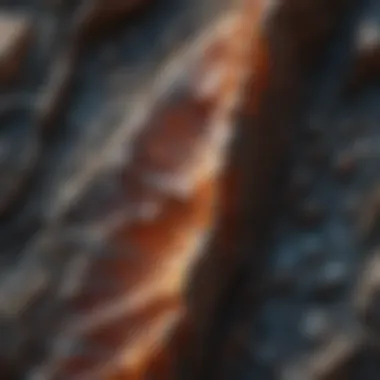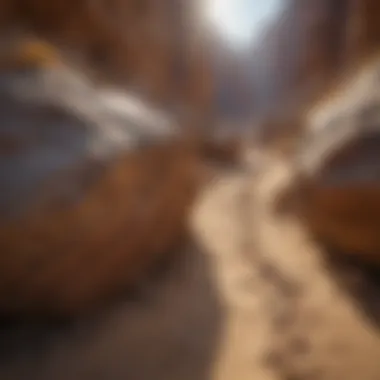Unveiling the Enigmatic Universe of Rocks in Geology


Rock and Fossil Identification
In the realm of geology, the identification of rocks and fossils serves as a foundational skill, enabling enthusiasts to unravel the mysteries of Earth's history. Understanding the types of rocks and fossils is essential, ranging from igneous formations like granite and basalt to the sedimentary layers of sandstone and limestone and the transformational metamorphic rocks such as marble and slate. Each classification offers a unique glimpse into the intricate tapestry of geological processes spanning millions of years. When embarking on the identification journey, keen eyes must be trained to spot key characteristics such as color, texture, hardness, and crystalline structures that define each specimen's nature. To aid in this discernment, utilizing specialized tools like magnifying lenses, hardness picks, and UV lights can provide further insights into the composition and origin of rocks and fossils, guiding collectors in their explorations.
Collecting Tips and Techniques
For rock and fossil collectors, mastering the art of successful specimen collection is paramount to building a diverse and fascinating collection. Best practices entail respecting nature and adhering to ethical guidelines, ensuring that collecting activities do not harm the environment or disturb natural habitats. Understanding the geological context is crucial, as prime collecting sites are often linked to specific rock formations, such as coastal cliffs for fossil hunting or volcanic terrains for igneous specimens. When extracting specimens, care must be taken to avoid damage, using specialized tools like rock hammers, chisels, and brushes to safely unearth and separate the rocks and fossils from their surroundings. Safety is of utmost importance, with collectors advised to wear protective gear like helmets, gloves, and sturdy footwear to prevent accidents during the extraction process.
Preservation and Display
Once the treasures of rocks and fossils have been collected, preserving them for posterity becomes a significant endeavor. Techniques for preservation vary depending on the specimen type, with methods including cleaning, stabilizing, and coating to prevent decay and degradation. Proper storage is essential to maintain the integrity of rocks and fossils, with considerations for factors like humidity, temperature, and light exposure influencing the choice of storage containers and environments. Displaying these geological wonders creatively can enhance their beauty and educational value, with options ranging from simple glass cases to elaborate dioramas or curated exhibitions that highlight the evolutionary stories encapsulated within each specimen.Through thoughtful preservation and imaginative display, collectors can share the wonders of the geological world with others, fostering a deeper appreciation for Earth's ancient history and natural marvels
Geological Insights
Delving into the geological insights offered by rocks and fossils unveils a rich tapestry of Earth's history and processes. From observing sedimentary layers that record ancient environments to exploring the intricate crystal structures of metamorphic rocks shaped by tectonic forces, each specimen holds clues to the planet's evolution over millennia. The historical significance of rocks and fossils extends beyond mere artifacts, with notable discoveries reshaping scientific understanding and evolutionary timelines. Whether studying geological formations like fault lines, volcanic vents, or mineral deposits, or uncovering rare fossils that depict prehistoric life forms, every find offers a window into the geological forces that have shaped our world.By delving into these geological insights, collectors not only enrich their own understanding but also contribute to the collective knowledge of the Earth's dynamic and ever-changing landscape.
Introduction to Rocks
In the vast domain of geology, rocks stand as the fundamental building blocks, offering a window into the Earth's history and processes that have shaped our planet over eons. Understanding the essence of rocks is crucial, as they hold clues to environmental changes, geological events, and even ancient life forms. This section elucidates the significance of rocks in geology, shedding light on their intrinsic value and the pivotal role they play in deciphering the Earth's narrative.
Understanding Rock Formation
Processes of Rock Formation
The processes governing the formation of rocks are intricate and multifaceted, encompassing a myriad of geological phenomena. From the solidification of molten magma to the compression of sediment layers, each mechanism contributes to the diverse spectrum of rock types found around the globe. Understanding these processes unveils the conditions prevailing during the formation of different rock types and aids in deducing the environmental factors that influenced their development.
Factors Influencing Formation
An array of factors influences the formation of rocks, dictating their composition, texture, and overall characteristics. Variables such as temperature, pressure, and environmental conditions play a pivotal role in shaping rock structures and properties. By exploring the factors that govern rock formation, geologists can unravel the environmental history encapsulated within rock formations, offering insights into past geological events.
Composition of Rocks
Mineral Composition
At the core of rock composition lies the arrangement of minerals, which define the physical and chemical properties of a rock. Various minerals, such as quartz, feldspar, and mica, contribute to the unique identity of different rock types. Analyzing the mineral composition of rocks provides valuable information about their origin, formation history, and geological significance.


Texture Variations
Texture variations in rocks offer crucial insights into their formation processes and environmental conditions during their development. Whether fine-grained or coarse-grained, the texture of a rock unveils the intricate patterns of mineral crystals, sediment deposition, and alteration processes that have sculpted its present form. Examining texture variations aids geologists in interpreting the genesis of rocks and understanding the dynamic forces that shaped them.
Significance of Rocks in Geology
Role in Geological Processes
Rocks serve as active participants in geological processes, acting as repositories of valuable information about Earth's dynamics and evolution. By studying the roles rocks play in phenomena like erosion, tectonic movements, and volcanic activities, geologists can decipher the intricate interplay between geological agents and rock formations, fostering a deeper appreciation for the Earth's complex systems.
Indicators of Earth's History
As archives of the Earth's past, rocks are indispensable tools for reconstructing the timeline of geological events and environmental changes that have occurred over millions of years. By examining the layers, structures, and fossils preserved in rocks, scientists can unravel the mysteries of Earth's history, uncovering clues about ancient climates, ecosystems, and even mass extinction events.
Classification of Rocks
Rocks play a crucial role in geology, serving as the foundational elements that contribute to understanding the Earth's history and geological processes. Through the classification of rocks, geologists can categorize and study the various types based on their distinct characteristics and origins. This categorization allows for a systematic approach to analyzing rocks, determining their composition, formation processes, and geological significance. By classifying rocks into groups such as igneous, sedimentary, and metamorphic, researchers can delve deeper into the complexities of the Earth's crust and decipher the intricate language written within rock formations.
Igneous Rocks
Formation and Characteristics
Igneous rocks form from the crystallization of magma or lava and exhibit unique characteristics that set them apart from other rock types. Their formation process involves the cooling and solidification of molten material, resulting in a fine-grained or coarse-grained texture. Igneous rocks are essential in understanding the Earth's internal dynamics and volcanic activities. Their distinct composition and cooling history provide valuable insights into the geological context of an area. By studying the formation and characteristics of igneous rocks, geologists can unravel the volcanic history of a region and decipher critical information about past geological events.
Types of Igneous Rocks
Igneous rocks are classified into two main types: intrusive and extrusive. Intrusive igneous rocks form below the Earth's surface, cooling slowly to produce large crystals, such as granite. On the other hand, extrusive igneous rocks solidify on the surface, cooling rapidly to form fine-grained textures, like basalt. Each type of igneous rock offers unique insights into the geological processes that shaped our planet over millions of years. By exploring the different types of igneous rocks, researchers can piece together the puzzle of Earth's volcanic history and understand the diverse range of igneous formations found worldwide.
Sedimentary Rocks
Depositional Environments
Sedimentary rocks are formed through the accumulation and compaction of sediments over time. Depositional environments play a critical role in shaping sedimentary rocks, with factors such as water flow, climate, and erosion influencing their formation. Understanding the depositional environments of sedimentary rocks offers valuable information about past geological conditions and environmental changes. By examining these environments, geologists can reconstruct ancient landscapes and interpret the Earth's history through the layers of sedimentary rock formations.
Examples of Sedimentary Rocks
Sedimentary rocks encompass a wide array of rock types, including limestone, sandstone, and shale. Each type of sedimentary rock holds clues to Earth's history, with fossils and sediment layers preserving valuable information about past ecosystems and climatic conditions. By studying examples of sedimentary rocks, researchers can piece together a timeline of geological events and understand the processes that have shaped the Earth's surface over millennia. The diversity of sedimentary rocks reflects the complex interplay of geological forces that have sculpted our planet's landscapes and recorded its evolutionary journey.


Metamorphic Rocks
Transformation Processes
Metamorphic rocks undergo a process of transformation under high temperatures and pressures, altering their mineral composition and texture. These rocks form from pre-existing rocks that undergo changes due to intense geological forces. Understanding the transformation processes of metamorphic rocks provides insight into the tectonic forces and geological events that have impacted the Earth's crust. By analyzing these processes, geologists can unravel the dynamic nature of the Earth's subsurface and glean information about ancient mountain-building events and plate tectonics.
Common Metamorphic Rocks
Common metamorphic rocks include marble, slate, and quartzite, each showcasing varying degrees of metamorphism and distinct mineral structures. These rocks are invaluable in deciphering the geological history of a region, with their unique characteristics revealing clues about the intensity of geological processes that have shaped them. By exploring common metamorphic rocks, researchers can reconstruct past tectonic events, understand the conditions under which these rocks formed, and interpret the complex interactions between heat, pressure, and geological forces that have sculpted the Earth's crust over geologic time scales.
Notable Geological Formations
Notable geological formations play a crucial role in unraveling the mysteries hidden within the Earth's crust. These formations serve as living records of the planet's geological past, providing invaluable insights into the processes that have shaped our landscapes over millions of years. By studying these remarkable formations, geologists can piece together the intricate puzzle of Earth's history, from ancient volcanic eruptions to shifting tectonic plates. Notable geological formations captivate the imagination and curiosity of both scientists and laypeople, showcasing the awe-inspiring power of geological forces at work.
Grand Canyon, USA
Formation History
The formation history of the Grand Canyon stands as a testament to the relentless forces of erosion that have sculpted this breathtaking natural wonder. Over millions of years, the Colorado River has carved its way through layers of rock, exposing a geological timeline that spans hundreds of millions of years. The distinct layers visible in the canyon's walls offer a vivid illustration of the Earth's complex geological history, with each stratum telling a unique story of deposition and transformation. The formation history of the Grand Canyon serves as a textbook example of how natural processes can shape our planet's landscapes, leaving behind a legacy of unparalleled beauty and scientific significance.
Rock Layers
The rock layers of the Grand Canyon provide a portal into the distant past, offering a glimpse into the ancient environments that once existed in this region. Each layer represents a different chapter in the Earth's history, containing clues about past climates, ecosystems, and geological events. From the ancient seas that once covered the area to the vast deserts that later emerged, the rock layers of the Grand Canyon are a treasure trove of geological information. By studying these layers, geologists can reconstruct the environmental conditions that prevailed during different epochs, shedding light on the ever-changing landscape of the Grand Canyon.
Giant's Causeway, Northern Ireland
Volcanic Origins
The Giant's Causeway stands as a striking testament to the power of volcanic activity in shaping the Earth's surface. The distinctive basalt columns that form this natural marvel are the remnants of ancient volcanic eruptions that occurred millions of years ago. These columns bear witness to the immense heat and pressure that once transformed molten rock into solid stone, creating the geometric patterns that have captivated visitors for centuries. The volcanic origins of the Giant's Causeway epitomize the dynamic nature of our planet, showcasing how geological forces continue to shape and reshape the Earth's terrain over geological timescales.
Basalt Columns
The basalt columns of the Giant's Causeway represent a geological spectacle unlike any other, with their hexagonal shapes standing as a testament to the natural phenomenon that created them. These columns are a striking example of columnar jointing, a process that occurs when lava cools and contracts, forming polygonal columns with remarkable symmetry. The unique geometry of the basalt columns at the Giant's Causeway has captured the imagination of scientists and tourists alike, highlighting the beauty and complexity of Earth's geological processes. Studying these columns provides valuable insights into the cooling mechanisms of lava flows and the fascinating patterns that emerge from the interplay of geology and geometry.
Impact of Rocks on Society
Rocks play a pivotal role in society, transcending mere geological significance to become fundamental components in various aspects of human life. The impact of rocks on society is profound and multifaceted, influencing everything from infrastructure development to cultural symbolism. Their importance in construction, as building materials and architectural marvels, cannot be overstated. Through their durability and versatility, rocks have shaped civilizations and continue to be essential elements in modern-day construction practices, showcasing their enduring relevance.


Utilization in Construction
Building Materials
Within the realm of construction, rocks serve as indispensable building materials, characterized by their durability and strength. Their resilience against environmental elements makes them a preferred choice for infrastructure projects worldwide. The unique feature of rocks as building materials lies in their ability to provide structural integrity and aesthetics simultaneously, offering architects and engineers a versatile medium for materializing their designs. Despite their advantages in construction, challenges such as weight and availability must be carefully addressed to ensure sustainable sourcing and utilization.
Architectural Marvels
Rocks have been instrumental in the creation of architectural marvels that stand as testaments to human ingenuity and engineering prowess. Their use in iconic structures around the world reflects their exceptional characteristics, including beauty, longevity, and sustainability. Architectural marvels crafted from rocks not only showcase the technical prowess of builders but also contribute to the preservation of cultural heritage. While the use of rocks in architecture provides remarkable advantages in terms of aesthetics and durability, considerations regarding maintenance and conservation play a crucial role in ensuring the longevity of these structures.
Cultural and Symbolic Significance
The cultural and symbolic significance of rocks transcends their physical attributes, becoming intertwined with the narratives of civilizations and belief systems. Historical artifacts made from rocks carry the essence of bygone eras, offering glimpses into ancient cultures and lifestyles. Their presence in archaeological excavations and museums serves as a tangible link to our past, enabling us to preserve and learn from history. However, the conservation and interpretation of historical rock artifacts pose challenges related to maintenance and ethical handling, necessitating a delicate balance between exploration and preservation.
Spiritual Associations
Moreover, rocks hold profound spiritual associations across diverse cultures, where they symbolize strength, wisdom, and connectivity to the earth. This spiritual symbolism manifests in rituals, monuments, and sacred sites that revere rocks as metaphysical entities embodying enduring qualities. The unique feature of spiritual associations with rocks lies in their ability to evoke deep emotions and contemplation, fostering a sense of harmony and interconnectedness with nature. While the spiritual significance of rocks enriches cultural practices and beliefs, discussions surrounding appropriation and conservation ethics emerge as essential considerations in maintaining respectful relationships with these revered elements.
Exploring the Depths of Geology
In this segment, we delve into the cornerstone of geology, emphasizing the critical role of understanding the intricacies that lie beneath the surface of our planet. The exploration of the depths of geology serves as the backbone of geological studies, unraveling the mysteries of rock formations and their transformative journey over millennia. By dissecting the rock cycle dynamics and survey techniques, we gain profound insights into the Earth's geological evolution.
Rock Cycle Dynamics
Continuous Processes
Diving deeper into the continuous processes within the rock cycle, we uncover the perpetual transformations occurring within Earth's crust. These processes, characterized by their ongoing nature without distinct breaks, showcase the perpetual evolution of rocks from one form to another. The seamless flow of rock alterations underlines the cyclic nature of geology, highlighting the interconnectedness of geological phenomena. While continuous processes offer a comprehensive view of rock evolution, their consistency in driving geological changes makes them a pivotal focus in understanding the dynamics of the Earth's crust.
Interconnected Phases
Examining the interconnected phases of the rock cycle reveals the intimate relationship between various geological processes. Each phase harmonizes with the next, creating a cohesive narrative of rock transformations that shape our planet's landscape. The interplay between these phases underscores the intricate dance of geological forces, influencing the formations we observe today. Understanding the interconnected phases provides a holistic perspective on the evolution of rocks, emphasizing the interdependence of geological phenomena in shaping the Earth's geological tapestry.
Geological Survey Techniques
In the realm of geology, the utilization of advanced survey techniques stands as a cornerstone in uncovering the Earth's geological secrets. Remote sensing, a technique leveraging satellite imagery and sensors to map geological features from a distance, offers a broad perspective on Earth's surface composition. This non-invasive method provides detailed insights into geological structures and formations, aiding geologists in their explorations.
Field observations, on the other hand, involve direct on-site inspections and data collection, allowing geologists to conduct a hands-on analysis of rock formations. This immersive approach enables detailed examinations of rock textures, structures, and compositions, providing valuable insights into the geological history of a particular area. The synergy between remote sensing and field observations offers a comprehensive understanding of geological features, combining the benefits of distant analysis with up-close observations for a well-rounded geological investigation.
Future Prospects in Rock Research
As technology advances, the field of rock research continues to evolve, presenting exciting prospects for geological study. Technological advancements such as high-resolution imaging and 3D modeling revolutionize how geologists analyze and interpret rock formations. These tools enhance the accuracy and depth of geological investigations, offering unprecedented insights into the Earth's complex geological processes.
Moreover, the environmental implications of rock research are gaining prominence, underscoring the need for sustainable practices in geological exploration. By considering the environmental consequences of research activities, geologists can minimize their ecological footprint while deriving valuable geological information. This proactive approach ensures that rock research remains ethically sound and environmentally conscious, paving the way for responsible geological investigations.







